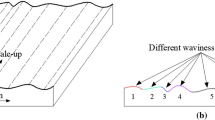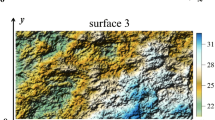Abstract
The mechanical and hydraulic anisotropy of rock joints are strongly dependent on the surface roughness and aperture. To date, accurate quantification of the anisotropic characteristics of joint surfaces remains a key issue. For this purpose, the digital image processing (DIP) technique was used to retrieve the joint surface topography, and a variogram function was used to characterize the anisotropy of the joint surface roughness and estimate the joint aperture. A new index, SR V , related to both the sill and the range of the variogram is proposed to describe the anisotropy of the joint surface roughness, and a new aperture index, b, is derived to quantify the joint aperture. These newly proposed indexes, SR V and b, were validated by characterizing three artificial triangular joint surfaces, then the values of both SR V and b were calculated along 42 directions on an artificial joint surface. The range of SR V was between 0.058622 and 0.331283, while that of b was from 0.270433 to 0.397715 mm. The results show that the newly proposed indexes SR V and b are effective for quantifying the anisotropic roughness and aperture of joint surfaces, respectively. In addition, based on the hypothesis that there exists a smooth upper wall for the artificial joint, a relationship between the indexes SR V and b was obtained based on the data analysis. It indicates that the trends of the indexes SR V and b tend to coincide, although some of their individual values differ. In this respect, the hydraulic aperture of rock joints is related to not only surface roughness but also the distribution of asperities on the surface. In addition, this method can also be used to characterize the roughness of real rock joints when the joint surface is treated by dying with ink before taking digital photos. This study provides a new method for properly quantifying the directional variability of joint surface roughness and estimating the mechanical and hydraulic properties of rock joints based on the DIP technique.






















Similar content being viewed by others
Abbreviations
- A :
-
Section area of trough (mm2)
- a :
-
Range (mm)
- b :
-
Equivalent hydraulic aperture (mm)
- C :
-
Sill (mm2)
- D :
-
Fractal dimension (dimensionless)
- D h :
-
Hydraulic diameter (mm)
- h :
-
Given sample spacing or lag (mm)
- h imax, h imin :
-
Maximum and minimum grey values of image (dimensionless)
- h max, h min :
-
Maximum and minimum asperity height of joint surface (mm)
- JRC:
-
Joint roughness coefficient (dimensionless)
- JRCComb :
-
Value of JRC obtained by comb method of Barton and Choubey (1977) (dimensionless)
- JRCDIP :
-
Value of JRC obtained by digital image processing method (dimensionless)
- JRCsuggested :
-
Value of JRC estimated by SR V (dimensionless)
- k :
-
Scale coefficient (dimensionless)
- L :
-
Length of joint surface (mm)
- L image :
-
Number of pixels of image along its length (pixels)
- N(h):
-
Total number of data pairs separated by certain spatial lag vector h of joint surface (dimensionless)
- P :
-
Perimeter of trough (mm)
- p :
-
Length of variogram curve (mm)
- R p :
-
Roughness profile index (dimensionless)
- S :
-
Area surrounded by curve of the variogram function (mm2)
- SR V :
-
Index quantifying the joint surface anisotropic behavior (dimensionless)
- Z 2 :
-
First derivative root mean square (dimensionless)
- z(x, y):
-
Height at location (x, y) on joint surface (mm)
- θ :
-
Directional angle (°)
- γ(h, θ):
-
Variogram function
- γ *(h, θ):
-
Experimental variogram function
References
Alameda-Hernández P, Jiménez-Perálvarez J, Palenzuela JA, El Hamdouni R, Irigaray C, Cabrerizo MA, Chacón J (2014) Improvement of the JRC calculation using different parameters obtained through a new survey method applied to rock discontinuities. Rock Mech Rock Eng 47(6):2047–2060
Aydan ö, Shimizu Y, Kawamoto T (1996) The anisotropy of surface morphology characteristics of rock discontinuities. Rock Mech Rock Eng 29(1):47–59
Babanouri N, Nasab SK, Sarafrazi S (2013) A hybrid particle swarm optimization and multi-layer perceptron algorithm for bivariate fractal analysis of rock fractures roughness. Int J Rock Mech Min Sci 60:66–74. doi:10.1016/j.ijrmms.2012.12.028
Barton N, Choubey V (1977) The shear strength of rock joints in theory and practice. Rock Mech 10(1–2):1–54
Belem T, Homand-Etienne F, Souley M (2000) Quantitative parameters for rock joint surface roughness. Rock Mech Rock Eng 33(4):217–242
Crandall D, Bromhal G, Karpyn ZT (2010) Numerical simulations examining the relationship between wall-roughness and fluid flow in rock fractures. Int J Rock Mech Min Sci 47(5):784–796
Develi K, Babadagli T (1998) Quantification of natural fracture surfaces using fractal geometry. Math Geol 30(8):971–998
Du SG, Hu YJ, Hu XF (2009) Measurement of joint roughness coefficient by using profilograph and roughness ruler. J Earth Sci 20(5):890–896
Ertunç G, Tercan AE, Hindistan MA, Ünver B, Ünal S, Atalay F, Kıllıoğlu SY (2013) Geostatistical estimation of coal quality variables by using covariance matching constrained Kriging. Int J Coal Geol 112(1):14–25
Fardin N, Feng Q, Stephansson O (2004) Application of a new in situ 3D laser scanner to study the scale effect on the rock joint surface roughness. Int J Rock Mech Min Sci 41(2):329–335
Feng Q, Fardin N, Jing L, Stephansson O (2003) A new method for in situ non-contact roughness measurement of large rock fracture rock surfaces. Rock Mech Rock Eng 36(1):3–25
Grasselli G (2006) Manuel Rocha medal recipient shear strength of rock joints based on quantified surface description. Rock Mech Rock Eng 39(4):295–314
Grasselli G, Egger P (2003) Constitutive law for the shear strength of rock joints based on three-dimensional surface parameters. Int J Rock Mech Min Sci 40(1):25–40
Hakami E, Larsson E (1996) Aperture measurements and flow experiments on a single natural fracture. Int J Rock Mech Min Sci Geomech Abstr 33(4):395–404
Kasmaee S, Gholamnejad J, Yarahmadi A, Mojtahedzadeh H (2010) Reserve estimation of the high phosphorous stockpile at the Choghart iron mine of Iran using geostatistical modeling. Min Sci Technol 20(6):855–860
Koyama T, Li B, Jiang Y, Jing L (2009) Numerical modelling of fluid flow tests in a rock fracture with a special algorithm for contact areas. Comput Geotech 36(1–2):291–303
Kulatilake PHSW, Shou G, Huang TH, Morgan RM (1995) New peak shear strength criteria for anisotropic rock joints. Int J Rock Mech Min Sci Geomech Abstr 32(7):673–697
Kulatilake PHSW, Um J, Pan G (1997) Requirements for accurate estimation of fractal parameters for self-affine roughness profiles using the line scaling method. Rock Mech Rock Eng 30(4):181–206
Kulatilake PHSW, Balasingam P, Park J, Morgan R (2006) Natural rock joint roughness quantification through fractal techniques. Geotech Geol Eng 24(5):1181–1202
Kulatilake PHSW, Park J, Balasingam P, Morgan R (2008) Quantification of aperture and relations between aperture, normal stress and fluid flow for natural single rock fractures. Geotech Geol Eng 26(3):269–281
Lee DH (2013) 3-Dimensional profile distortion measured by stylus type surface profilometer. Measurement 46(1):803–814
Maerz NH, Franklin JA, Bennett CP (1990) Joint roughness measurement using shadow profilometry. Int J Rock Mech Min Sci Geomech Abstr 27(5):329–343
Mah J, Samson C, McKinnon SD, Thibodeau D (2013) 3D laser imaging for surface roughness analysis. Int J Rock Mech Min Sci 58:111–117
Murato S, Saito T (1999) The variogram method for a fractal model of a rock joint surface. Geotech Geol Eng 17(3–4):197–210
Neves M, Gomes DP (2011) Geostatistics for spatial extremes. A case study of maximum annual rainfall in Portugal. In: 1st International Conference on Spatial Statistics—Mapping Global Change, Enschede, The Netherlands, 23–25 Mar 2011. Procedia Environmental Sciences, pp 246–251
Rasouli V, Hosseinian A (2011) Correlations developed for estimation of hydraulic parameters of rough fractures through the simulation of JRC flow channels. Rock Mech Rock Eng 44(4):447–461
Roko RO, Daemenj JJK, Myers DE (1997) Variogram characterization of joint surface morphology and asperity deformation during shearing. Int J Rock Mech Min Sci 34(1):71–84
Snow DT (1965) A parallel plate model of fractured permeable media. PhD thesis, University of California, Berkeley
Srivastava RM (2013) Geostatistics: a toolkit for data analysis, spatial prediction and risk management in the coal industry. Int J Coal Geol 112(1):2–13
Sun HQ (1990) Geostatistics and its application. China University of Mining and Technology Press, Xuzhou
Tatone BSA, Grasselli G (2010) A new 2D discontinuity roughness parameter and its correlation with JRC. Int J Rock Mech Min Sci 47(8):1391–1400
Tatone BSA, Grasselli G (2012) Quantitative measurements of fracture aperture and directional roughness from rock cores. Rock Mech Rock Eng 45(4):619–629
Tse R, Cruden DM (1979) Estimating joint roughness coefficients. Int J Rock Mech Min Sci Geomech Abstr 16(5):303–307
Wolski M, Podsiadlo P, Stachowiak GW (2010) Applications of the variance orientation transform method to the multi scale characterization of surface roughness and anisotropy. Tribol Int 43(11):2203–2215
Xia CC, Tang ZC, Xiao WM, Song YL (2014) New peak shear strength criterion of rock joints based on quantified surface description. Rock Mech Rock Eng 47(2):387–400
Xie HP (1995) Fractal description of rock joint. Chin J Geotech Eng 17(1):18–23
Yang ZY, Lo SC (1997) An index for describing the anisotropy of joint surfaces. Int J Rock Mech Min Sci 34(6):1031–1044
Yang ZY, Di CC, Lo SC (2001a) Two-dimensional Hurst index of joint surfaces. Rock Mech Rock Eng 34(4):323–345
Yang ZY, Lo SC, Di CC (2001b) Reassessing the joint roughness coefficient (JRC) estimation using Z 2. Rock Mech Rock Eng 34(3):243–251
Acknowledgments
This work is funded by the National Science Foundation of China (Grant Nos. 51222401, 51374049, and 51304037), the Key Project of Chinese Ministry of Education (no. 113019A), the Fundamental Research Funds for the Central Universities of China (Grant Nos. N120101001 and N140105001), and the Research Fund for the Doctoral Program of Higher Education of China (Grant No. 20110042110035). This support is gratefully acknowledged.
Author information
Authors and Affiliations
Corresponding author
Rights and permissions
About this article
Cite this article
Chen, S.J., Zhu, W.C., Yu, Q.L. et al. Characterization of Anisotropy of Joint Surface Roughness and Aperture by Variogram Approach Based on Digital Image Processing Technique. Rock Mech Rock Eng 49, 855–876 (2016). https://doi.org/10.1007/s00603-015-0795-x
Received:
Accepted:
Published:
Issue Date:
DOI: https://doi.org/10.1007/s00603-015-0795-x




